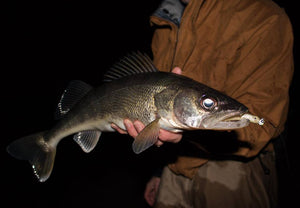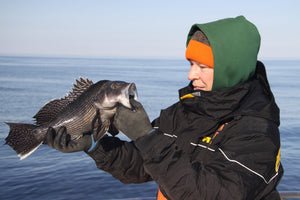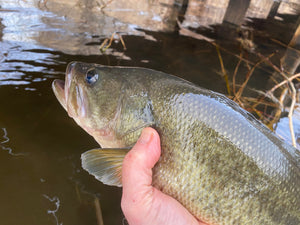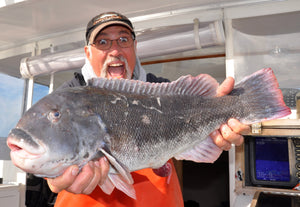Hoping For An East End Squid Run

Squid have a large following along Long Island’s saltwater faithful. To a large degree that’s because these ten-armed, soft-skinned mollusks make such tasty treats when fried, sautéed, barbecued or even pan-seared and added to salads. For some anglers the squid’s appeal to massive fluke, tiderunner weakfish and even cow bass can also be a draw, especially for those adept at live-lining them in pockets of slow-moving water around bulkheads, docks, large boulders and similar structure.
Still, it’s likely the biggest attraction to squid fishing comes from the way they’ll grab a jig. Squid, you see, are complex enough to test your angling skills yet still agreeable to the point that success is nearly guaranteed should you locate their schools. Compared to most other types of briny fishing, casting for these colorful creatures is relaxing sport that provides an opportunity to converse and enjoy a night outdoors while icing dinner.

Although most squid hold offshore throughout the year, a sizeable inshore migration does take place in the spring when water temperatures range from 50 to 55 degrees. Usually, squid arrive in our East End bays, coves and river mouths a week or two before migrating school stripers. Once the predators catch up and the water begins to warm the squid quickly scatter and action comes to a screeching halt. Cool winters and persistent northeast winds sometimes prolong the run, perhaps stretching it to a month or more. In recent years, however, the peak of the season has been brief - often lasting only one or two weeks. Thus, it’s vital to get on this quarry as soon as rumors of their arrival begin to surface.
Like many northeast predator species, squid tend to move inshore on flooding tides and feed ravenously through the start of the ebb. As a rule, they prefer protected areas with mild currents such as coves, harbors, slow-moving tidal rivers, and pocket or eddy waters located at the tail end of an inlet or tucked inside a cove or harbor area. Although you can catch them just off the bottom in daylight during years featuring strong runs, most squid fans target these mysterious creatures after dark from well-lighted docks (many anglers bring their own portable lights to more tightly concentrate the schools beneath their feet).

Timing the squid run takes a little guesswork, but it’s not overly difficult. Usually, initial catches will be noted in local fishing reports. A sure-fire sign the squid have arrived is the sight of several anglers huddled together after dark while working shadow lines along a dock, pier, bridge or bulkhead. From late April through May, make it a point to check your local docks a couple times each week and you should get a sense as to whether the action is building. On the East End in particular, any dock on Peconic or Shinnecock bay, or that allows legal late-night access to points further east, is worth investigating.
Although squid can at times be tempted with small pieces of baitfish, squid jigs are the primary weapon in this game and their superiority over other offerings is unchallenged. Squid jigs come in a variety of colors, sizes and styles. Some are holographic, a few glow in the dark, others are designed to sink fast for deep fishing, sink slowly, glide horizontally or present as neutrally buoyant for fishing in shallow water. When the squid come in thick, any of these can catch with ease.
Squid jig color preference varies from trip to trip and port to port, but you’ll rarely go wrong carrying a few three- to four-inch jigs in pink, blue, green and pearl. Of course, we offer nearly a dozen different squid jigs here at the shop, including Yo-Zuri Ultra Bait Squids Jigs, Yo-Zuri Ultra Cloth Squid Jigs, Yo-Zuri Floating Squid Jigs, Tsunami Soft Body Squid Sabiki Rigs, and Promar Ahi 5-Hook Squid Gangion Chains. All are priced between $4.99 and $8.99, and tips and instruction come free.
Since most squid fishing can be accomplished with minimal casting it is possible to use either spinning or conventional gear. If you just want to enjoy yourself, choose an eight- to 12-pound class outfit and tie on a single squid jig sans leader. To fill the cooler, opt for something that can manage 15-to 20-pound test line so you’ll be able to work multiple jigs and lift two or more squid at a time. For this setup, anchor a three- to five-foot monofilament leader with a small weight and use two-inch dropper loops spaced 6 to 12 inches apart to secure two or more jigs.

As for hooking-up, it all boils down to imparting a smooth, simple action. Whether you try from boat or shore, daytime fishing usually requires a yo-yo motion in which the jig is gently lifted up two or three feet and allowed to drop back down on a slack line.
For night fishing, an unweighted jig can be allowed to settle toward the bottom until nearly out of sight before a smooth lift of the rod is used to glide the lure back toward the surface. Do this and you’ll often see an interested squid change color from light green, pink or white to dark red just before it strikes. Sometimes, simply allowing the jig to remain motionless at the end of the line works better than any other presentation. The key is to keep experimenting until you find something that works. Occasionally, the night bite stays deep and out of sight, requiring the use of weighted daytime rigs to connect.
All squid jigs have in common a special multi-point barbless hook designed to entangle a squid’s arms as it grabs the lure. With these hooks, there is no need to set with a sharp snap. Rather, use a steady lift and tight line to keep the squid attached as you reel it to the surface. As you lift each squid, be sure to let it dangle above the water for five to ten seconds. This gives your quarry a little time to squirt most of its ink as it spins with arms flailing like helicopter blades. You can then jiggle the squid over an open cooler or bucket until it slides off the jig. Be aware that few squid expel all their ink in one shot, and the odds are that you’ll be the recipient of at least a couple of splats each trip. Don’t wear your Sunday duds.
It should be noted that the past few springs have seen limited squid action in our inshore waters. Surveys, however, show the squid, both longfin and the occasional shortfin versions, currently have stable populations. Why the little buggers have been passing up our bays and harbors of late remains a mystery at this point but hope springs eternal. Let’s root for the squid to make a strong showing this spring, and for them tow along plenty of big fluke, weakfish and stripers in their wake.
- Bryce Poyer






